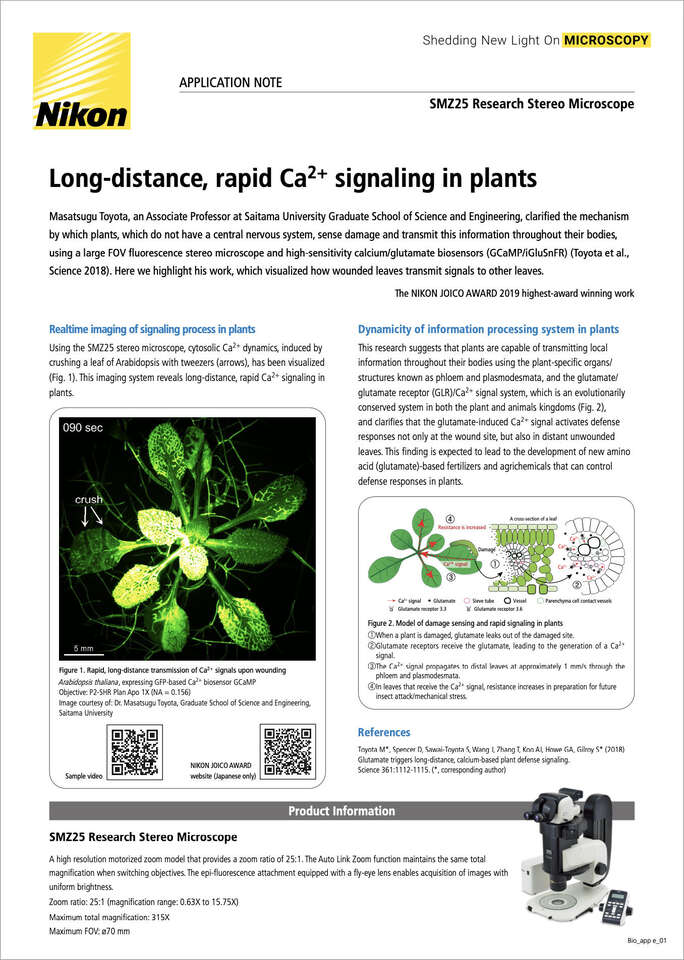- en Change Region
- Global Site
Application Notes

Long-distance, rapid Ca2+ signaling in plants
January 2024
Masatsugu Toyota, an Associate Professor at Saitama University Graduate School of Science and Engineering, clarified the mechanism by which plants, which do not have a central nervous system, sense damage and transmit this information throughout their bodies, using a large FOV fluorescence stereo microscope and high-sensitivity calcium/glutamate biosensors (GCaMP/iGluSnFR) (Toyota et al., Science 2018). Here we highlight his work, which visualized how wounded leaves transmit signals to other leaves.
The NIKON JOICO AWARD 2019 highest-award winning work
Realtime imaging of signaling process in plants
Using the SMZ25 stereo microscope, cytosolic Ca2+ dynamics, induced by crushing a leaf of Arabidopsis with tweezers (arrows), has been visualized (Fig. 1).This imaging system reveals long-distance, rapid Ca2+ signaling in plants.
Figure 1. Rapid, long-distance transmission of Ca2+ signals upon wounding Arabidopsis thaliana , expressing GFP-based Ca2+ biosensor GCaMP
Objective: P2-SHR Plan Apo 1X (NA = 0.156)
Image courtesy of: Dr. Masatsugu Toyota, Graduate School of Science and Engineering, Saitama University
Dynamicity of information processing system in plants
This research suggests that plants are capable of transmitting local information throughout their bodies using the plant-specific organs/ structures known as phloem and plasmodesmata, and the glutamate/ glutamate receptor (GLR)/Ca2+ signal system, which is an evolutionarily conserved system in both the plant and animals kingdoms (Fig. 2),
and clarifies that the glutamate-induced Ca2+ signal activates defense responses not only at the wound site, but also in distant unwounded leaves. This finding is expected to lead to the development of new amino acid (glutamate)-based fertilizers and agrichemicals that can control defense responses in plants.
Figure 2. Model of damage sensing and rapid signaling in plants
① When a plant is damaged, glutamate leaks out of the damaged site.
② Glutamate receptors receive the glutamate, leading to the generation of a Ca2+ signal.
③ The Ca2+ signal propagates to distal leaves at approximately 1 mm/s through the phloem and plasmodesmata.
④ In leaves that receive the Ca2+ signal, resistance increases in preparation for future insect attack/mechanical stress.
References
Toyota M*, Spencer D, Sawai-Toyota S, Wang J, Zhang T, Koo AJ, Howe GA, Gilroy S* (2018) Glutamate triggers long-distance, calcium-based plant defense signaling.
Science 361:1112-1115. (*, corresponding author)
Product Information
SMZ25 Research Stereo Microscope
A high resolution motorized zoom model that provides a zoom ratio of 25:1. The Auto Link Zoom function maintains the same total magnification when switching objectives.The epi-fluorescence attachment equipped with a fly-eye lens enables acquisition of images with uniform brightness.
Zoom ratio: 25:1 (magnification range: 0.63X to 15.75X)
Maximum total magnification: 315X
Maximum FOV: ø70 mm
